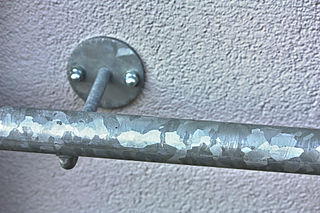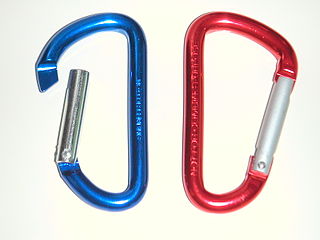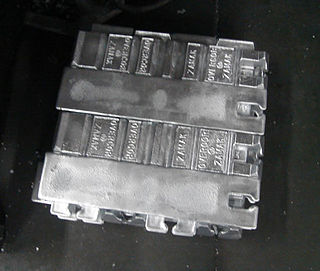Related Research Articles

Galvanization or galvanizing is the process of applying a protective zinc coating to steel or iron, to prevent rusting. The most common method is hot-dip galvanizing, in which the parts are submerged in a bath of hot, molten zinc.
Passivation, in physical chemistry and engineering, refers to coating a material so it becomes "passive", that is, less readily affected or corroded by the environment. Passivation involves creation of an outer layer of shield material that is applied as a microcoating, created by chemical reaction with the base material, or allowed to build by spontaneous oxidation in the air. As a technique, passivation is the use of a light coat of a protective material, such as metal oxide, to create a shield against corrosion. Passivation of silicon is used during fabrication of microelectronic devices. In electrochemical treatment of water, passivation reduces the effectiveness of the treatment by increasing the circuit resistance, and active measures are typically used to overcome this effect, the most common being polarity reversal, which results in limited rejection of the fouling layer.

Chrome plating is a technique of electroplating a thin layer of chromium onto a metal object. A chrome-plated item is called chrome. The chromed layer can be decorative, provide corrosion resistance, ease of cleaning, or increase surface hardness. Sometimes, a less expensive imitator of chrome may be used for aesthetic purposes.

Anodizing is an electrolytic passivation process used to increase the thickness of the natural oxide layer on the surface of metal parts.
Plating is a surface covering in which a metal is deposited on a conductive surface. Plating has been done for hundreds of years; it is also critical for modern technology. Plating is used to decorate objects, for corrosion inhibition, to improve solderability, to harden, to improve wearability, to reduce friction, to improve paint adhesion, to alter conductivity, to improve IR reflectivity, for radiation shielding, and for other purposes. Jewelry typically uses plating to give a silver or gold finish.

A primer or undercoat is a preparatory coating put on materials before painting. Priming ensures better adhesion of paint to the surface, increases paint durability, and provides additional protection for the material being painted.

ZAMAK is a family of alloys with a base metal of zinc and alloying elements of aluminium, magnesium, and copper.

Chromate conversion coating or alodine coating is a type of conversion coating used to passivate steel, aluminium, zinc, cadmium, copper, silver, titanium, magnesium, and tin alloys. The coating serves as a corrosion inhibitor, as a primer to improve the adherence of paints and adhesives, as a decorative finish, or to preserve electrical conductivity. It also provides some resistance to abrasion and light chemical attack on soft metals.

Electroless nickel-phosphorus plating is a chemical process that deposits an even layer of nickel-phosphorus alloy on the surface of a solid substrate, like metal or plastic. The process involves dipping the substrate in a water solution containing nickel salt and a phosphorus-containing reducing agent, usually a hypophosphite salt. It is the most common version of electroless nickel plating and is often referred by that name. A similar process uses a borohydride reducing agent, yielding a nickel-boron coating instead.

Zinc chromate, ZnCrO4, is a chemical compound containing the chromate anion, appearing as odorless yellow powder or yellow-green crystals, but, when used for coatings, pigments are often added. It is used industrially in chromate conversion coatings, having been developed by the Ford Motor Company in the 1920s.
A conversion coating is a chemical or electro-chemical treatment applied to manufactured parts that superficially converts the material into a thin adhering coating of an insoluble compound. These coatings are commonly applied to protect the part against corrosion, to improve the adherence of other coatings, for lubrication, or for aesthetic purposes.

Barium chromate, named barium tetraoxochromate(VI) by the IUPAC, is a yellow sand like powder with the formula BaCrO4. It is a known oxidizing agent and produces a green flame when heated, a result of the barium ions.
Phosphate conversion coating is a chemical treatment applied to steel parts that creates a thin adhering layer of iron, zinc, or manganese phosphates, to achieve corrosion resistance, lubrication, or as a foundation for subsequent coatings or painting. It is one of the most common types of conversion coating. The process is also called phosphate coating, phosphatization, phosphatizing, or phosphating. It is also known by the trade name Parkerizing, especially when applied to firearms and other military equipment.
Electrogalvanizing is a process in which a layer of zinc is bonded to steel in order to protect against corrosion. The process involves electroplating, running a current of electricity through a saline/zinc solution with a zinc anode and steel conductor. Such Zinc electroplating or Zinc alloy electroplating maintains a dominant position among other electroplating process options, based upon electroplated tonnage per annum. According to the International Zinc Association, more than 5 million tons are used yearly for both hot dip galvanizing and electroplating. The plating of zinc was developed at the beginning of the 20th century. At that time, the electrolyte was cyanide based. A significant innovation occurred in the 1960s, with the introduction of the first acid chloride based electrolyte. The 1980s saw a return to alkaline electrolytes, only this time, without the use of cyanide. The most commonly used electrogalvanized cold rolled steel is SECC, acronym of "Steel, Electrogalvanized, Cold-rolled, Commercial quality". Compared to hot dip galvanizing, electroplated zinc offers these significant advantages:
Galvannealed or galvanneal is the result from the processes of galvanizing followed by annealing of sheet steel.

Calcium chromate is an inorganic compound with the formula CaCrO4, i.e. the chromate salt of calcium. It is a bright yellow solid which is normally found in the dihydrate form CaCrO4·2H2O. A very rare anhydrous mineral form exists in nature, which is known as chromatite.
Bethanization is a process patented by the Bethlehem Steel Company to protect steel from corrosion by plating it with zinc, a process similar to electrogalvanization. In advertising materials, Bethlehem Steel claimed the process was more effective than hot dip galvanization, the most common means of using zinc to protect steel.
Cadmium chromate is the inorganic compound with the formula CdCrO4. It is relevant to chromate conversion coating, which is used to passivate common metal alloys such as aluminum, zinc, cadmium, copper, silver, magnesium, and tin. In conversion coating chromate reacts with these metals to prevent corrosion, retain electrical conductivity, and provide a finish for the appearance of the final alloy products. This process is commonly used on hardware and tool items. Chromate species take on their distinctive yellow color when coated.
According to EN 13523-0, a prepainted metal is a ‘metal on which a coating material has been applied by coil coating’. When applied onto the metallic substrate, the coating material forms a film possessing protective, decorative and/or other specific properties.

Strontium chromate is a chemical compound, with the formula SrCrO4.
References
- ↑ Gregory Zhang, Xiaoge (1996). Corrosion and Electrochemistry of Zinc. Springer Verlag Gmbh. pp. 16, 17. ISBN 978-1-4757-9877-7 . Retrieved 12 December 2014.
- ↑ USpatent 2035380,Ernest John Wilhelm,"Method of coating zinc or cadmium base metals",published 1936-03-24,issued 1936-03-24, assigned to The New Jersey Zinc Company